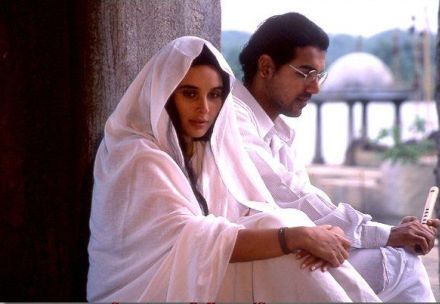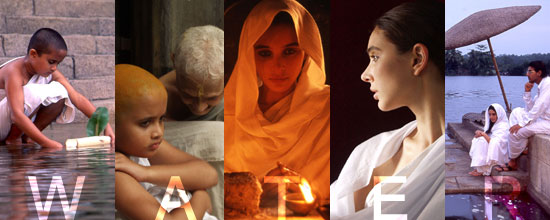5. Remember Shakuntala’s long look at the end of the movie? What does that look mean?
Suggested Response:
Here are a few of the possible responses: (1) she is turning to face her life, a life in which she had given up Chuyia, the one person that she had come to love; (2) her faith was gone and the years of a life of privation without the assistance of her faith stretched out before her; (3) Shakuntala is thinking of the terrible things that were done to young girls for the benefit of the ashram; (4) she is thinking of Kalyani and how she had hoped that Kalyani would be going away with Narayan; (5) she could not go back to the ashram after having taken away a necessary source of income (prostituting Chuyia) and she is thinking of the very difficult life that she now faced; (6) she is looking at us, the audience, to share the despair at her situation, the horror of what she has just seen, or for help; (7) she is just reflecting after having made a leap of conscience and faith to give Chuyia to Gandhi; or (8) she was still in shock about what happened to Chuyia and that she has had to send Chuyia away.
6. There was one other character in the film, other than Shakuntala, who had to decide between the traditional faith and prejudices of society and the demands of conscience. Who was it and what was the decision?
Suggested Response:
The character was Narayan. Most Indian men would not marry a widow and almost every man of his time would insist that his bride be a virgin. These traditional beliefs, however, collided with Narayan’s understanding of Kalyani’s situation and his love for her. Kalyani had not been a willing prostitute. It was against Narayan’s conscience that she should suffer for something she had been forced to do. (Some might suggest that another character torn between faith and tradition on one side and conscience on the other was Kalyani. She did have a dilemma. But her choice was between tradition/faith and love and hope for a better life. Kalyani’s dilemma did not involve her conscience.)
7. What would you do if you were convinced that the requirements of love and respect conflict with the rules that your religion has set down as proper conduct?
Suggested Response:
There is no one correct response to this question. A strong argument could be made that Gandhi’s solution is best, to strip faith down to its essence and throw away all the rules that conflict with the basic ideals. However, this can be a slippery slope leading to unethical conduct. The best example is Narayan’s father who allowed himself to believe that as an upper caste Brahman, he was conferring a blessing on Kalyani by sleeping with her. He picked the wrong element of his religion to stress (the caste system) and threw away the important ones (caring for others; not hurting others, respect for others). Obviously, this was a contention motivated by self-interest.
8. The priest tells Shakuntala, that whatever happens, she should not lose her faith. Was this good advice? Did she lose her faith?
Suggested Response:
It all depends upon what he meant by faith. If her faith was that the way of action should be determined by love and respect (and the rules of conduct derived from them, see for examples the The Six Pillars of Character), then he gave her good advice. If he meant the belief in god of whatever form she adhered to, then the advice was good. If he meant the specific rules of conduct set down in ancient texts, such as the rules prohibiting widows from remarrying, then this was not good advice.
(B) The Weight of Tradition
9. Why didn’t Kalyani just leave the ashram or fight harder for her love and her life?
Suggested Response:
Where was she going to fight from? She lived in a society bound by tradition. She was uneducated and didn’t know about Gandhi and the changes he was promoting. She had no money. She had no friends. She had no place to live. She didn’t know anyone who would help her. She was certainly justified in believing that Narayan wouldn’t help her after she had served as a prostitute for his father. Most men at that time wouldn’t even consider marrying a woman who wasn’t a virgin, and this was worse.
10. In this film, Shakuntala and Kalyani faced similar crises. What were they and how did they resolve them?
Suggested Response:
The crises were the challenges to their faith and the traditions of their society. At the beginning of the movie, both women accepted the restrictions placed on widows by what they believed were the requirements of their religion and by their traditions. At the beginning of the movie, both of them accepted the fact that young widows would serve as prostitutes so that the ashram could survive. During the movie both of them rejected these concepts. Another way to say it is that widows were not supposed to find love. Both of them, however, did. Kalyani came to love Narayan and Shakuntala came to care for Chuyia as if Chuyia were her daughter.
11. Why didn’t Shakuntala get on the train with Chuyia?
Suggested Response:
We aren’t told the reason and it is left ambiguous. But whatever it was, she wasn’t ready to make the complete break with her faith, with tradition and with her life as a widow. Unlike Chuyia, she was not going to be prostituted if she returned to the ashram. Chuyia, being a mere child, had more to live for than a woman who had been a widow and lived in the ashram for many years.
(C) The Oppression and Abuse of Women in a Patriarchal Society
12. In a patriarchal society in which women do not have rights, what happens to women who are not under the protection of a man?
Suggested Response:
They are often taken advantage of.
13. What is the most subversive line in the film? Chuyia says it. How do the adults around her react?
Suggested Response:
The line is: “Where are the houses for the men widows?” The widows around her react with horror that anyone could think of visiting such a terrible fate on their men. This is extremely ironic because their men have no compunction about making the widows’ lives miserable.
14. What of the male spiritual counselor’s statement that, “We only follow the laws that benefit us”? Certainly, following the law would have benefitted widows. Who was the “us” he was referring to?
Suggested Response:
The laws were made by the British occupiers. The Indians didn’t participate in making the laws and felt that they had no obligation to obey them. Apparently, the men in India didn’t object to the treatment of widows. According to Narayan and many other commentators, the motivation was economic. When a widow was sent away, not only was there one less mouth to feed, one less Sari to buy, and more room in the hut, but also businesses were often family affairs and if the widow was sent away and had no rights, the brothers got the share that would have gone to the widow. The “us” meant “Indian men”.
(D) Can Someone Forced to Live in Corruption Like Kalyani Retain her Integrity?
15. Kalyani quotes a saying attributed to Krishna: “Learn to live like a lotus untouched by the filthy water it grows in.” What does this mean, why does she need to believe this, and what role does this saying play in the organization of her personality?
Suggested Response:
This means that even if she is forced to be a prostitute she can still be a good person. This piece of religious faith allows her to compartmentalize the prostitution from the rest of her life and retain her sense of self-worth. The metaphor of the lotus is central to the organization of Kalyani’s personality. However, when she discovers that one of her “clients” had been Narayan’s father, she comes to believe that the outside world will no longer allow her to maintain this compartmentalization and that the taint of her prostitution will destroy her one chance for happiness. This is too much for her and she commits suicide. She underestimates the power of Narayan’s love for her.
16. What do you think about the lotus verse? Can a person live among corruption and not be tainted?
Suggested Response:
There is no one correct answer to this question. Certainly, it takes a very extraordinary person to pull this off and for most of us it is impossible. The message of the movie is equivocal. Ultimately, Kalyani decided that after having loved Narayan it was impossible for her to maintain her integrity if she allowed herself to be prostituted again. She underestimated the strength of Narayan’s love and didn’t think he would come back for her.
PLOT
17. This movie is the story of three great loves. What are they?
Suggested Response:
The first two are easy. Kalyani’s love for Narayan and his love for her. The third is Shakuntala’s love for Chuyia as a daughter.
18. This plot consists of several stories that are linked together. What are they?
Suggested Response:
One is the tale of Chuyia, a child widow, who is sent away from home to a widows’ ashram where she is sexually abused. Second, is the Kalyani/Narayan romance. The third is the story of Shakuntala’s crisis of faith.
19. Narayan and his friend talk about Shakespeare’s play “Romeo and Juliet”. What element of the plot in the movie is similar to a plot element in “Romeo and Juliet”?
Suggested Response:
The similar plot element is that the timing of the lovers is just a bit off and that little bit causes people to die. Narayan comes to the ashram to get Kalyani but he’s too late. She has already committed suicide. In “Romeo and Juliet”, it’s just the opposite. If Romeo had come just a little later, Juliet would have revived and they would not have committed suicide. Another good response is that the similarity is that one of the lovers commits suicide.
20. What is the role of Chuyia in telling the story of this film?
Suggested Response:
Chuyia is used throughout the movie as an agent of explication and change. It is through the character of Chuyia that the audience is first introduced to Madhumati, then to Shakuntala, then to Kalyani, and finally to Narayan. After the first few scenes at the ashram, until the end of the story, Chuyia advances the plot in ways that are not central to her story. For example, it is Chuyia who tells Madhumati about Kalyani’s plans to marry, Chuyia who kills Mitthu, Chuyia who tells Shakuntala that she looks old, and Chuyia who asks the question about the location of the houses of the men widows. Finally, it is Chuyia who sparks Shakuntala’s motherly instincts, the instincts that fuel much of the older woman’s rebellion of conscience against the customs of traditional Indian society. While the focus of the plot starts with Chuyia, it soon shifts to the Kalyani/Narayan love story, and then to the story of Shakuntala’s crisis of faith. Only at the very end of the film does Chuyia again become a major participant in the plot.
FORESHADOWING
21. Three living beings are broken in the course of the movie. What are the circumstances of each?
Suggested Response:
Out of anger at Madhumati, Chuyia kills Mitthu by breaking its back. The bird falls to the floor. Chuyia herself then gets broken when she is sent out by Madhumati for a sexual assignment with Narayan’s father. In a sense Kalyani is broken, but not physically, and dies like Mitthu when she leaves the cage of tradition.
22. Early in the movie we see dark rain clouds. What do they foretell?
Suggested Response:
Doom, a tragic ending.
SYMBOL
Questions 2 & 3 in the Learning Guide refer to symbols in the film.
23. The character of Madhumati, the fat widow, is a symbol. What is she a symbol of? Is there anything sympathetic about this woman?
Suggested Response:
Madhumati is a symbol of the corruption of the system. She is fat, but widows are supposed to eat only one meal a day and to be deprived of pleasures of the flesh, including eating. Widows are supposed to sleep on mats on the floor. Madhumati has a bed. Widows are not supposed to take drugs. Madhumati gets a drug from Gulabi and smokes it. Ashrams are not supposed to be brothels but Madhumati acts as a madam. But she is not simply a one-dimensional villain. Her corruption in prostituting Kalyani and Chuyia is the corruption of all of the widows in the ashram, since they all benefit. As the leader of the ashram, Madhumati must make sure it can pay the rent. The income from begging and saying prayers is not enough to do that. Someone must arrange for “servicing” the local gentry.
24. Water is a symbol. What does it symbolize?
Suggested Response:
See Symbols
25. The character of Narayan is a symbol. What does he symbolize?
Suggested Response:
See Symbols
26. Why does Narayan quote a poem about a cloud messenger?
Suggested Response:
The clouds shown by the movie are dark and foreboding, foretelling a tragic outcome.
IRONY
27. Cite three examples of irony in this movie.
Suggested Response:
See Literary Devices section on Irony.
CHARACTERIZATION
28. Which character changed the most through the course of the movie? Describe the pressures that caused that character to change.
Suggested Response:
There are two possible good answers: Kalyani and Shakuntala. Kalyani had accepted her life as a widow/prostitute until she met Narayan and she began to seek a full life as a woman in a loving marriage. After she loved Narayan she could no longer stand to be a prostitute. It was the pressure of her love for Narayan that caused her to change. Shakuntala was not happy with her life, but she was comfortable in her beliefs before the Narayan-Kalyani romance and the prostituting of Chuyia. Shakuntala began to question her beliefs and understood that her conscience could not tolerate what was happening to the widows, especially Kalyani and Chuyia. It was her sense of justice and her outrage that caused her to change. At the end of the film, she gave Chuyia to Narayan but was unable to join Gandhi herself and completely reject the traditional notions about widowhood.
29. Who is the most enigmatic character in the film?
Suggested Response:
The male spiritual counselor of the ashram. He bemoans India’s ignorance but counsels the women to keep their faith.
CHUYIA
30. Describe Chuyia’s character and personality during the time she is at the ashram.
Suggested Response:
She is feisty, strong and resilient. Chuyia kills Mitthu and screams at Madhumati, tramples on the old woman’s back, and bites her. Chuyia can also be kind, thoughtful and forgiving. She gives food to the dog and brings back a sweet for the old widow.
31. Put yourself in Chuyia’s shoes. Eight years old; sent by her family to the ashram and abandoned there with no idea how to get home; living with these strange old women in deprived circumstances. And then the old widow dies, Kalyani dies, and Chuyia herself is sexually abused. Shakuntala, the only widow left who has shown her any affection, shoves her onto a train. What could be going on in Chuyia’s mind?
Suggested Response:
She has been abandoned and betrayed many times. The wound must be very deep. She would have clung very hard to Narayan.
SHAKUNTALA
32. Before Chuyia came what did Shakuntala, as a widow, miss in her life? Gandhi told us.
Suggested Response:
There was no one to love her or for her to love.
33. What was Shakuntala’s situation when she was listening to Gandhi at the train station?
Suggested Response:
She had to make a decision about what to do with Chuyia. Shakuntala had come to love Chuyia as a daughter. If she took Chuyia back to the ashram, the child would be prostituted again by Madhumati and Gulabi. However, there was no other place for them to go. If they left the ashram they would starve. The only solution was to give the child up to the care of Gandhi. She was left, again, with no one to love or to love her.
34. Who did Shakuntala love and what happened to that love?
Suggested Response:
She loved Chuyia and she gave Chuyia up because she knew that the best thing for Chuyia was to leave the ashram and grow up in Gandhi’s care.
35. What was the significance of the scene in which Shakuntala asks Chuyia what she looks like and the girl responds that Shakuntala looks old?
Suggested Response:
Shakuntala comes to realize that life has passed her by without ever offering her the opportunity to love and be loved.
KALYANI
36. Kalyani and Mitthu, the bird of Madhumati, are symbolically linked. Describe those links.
Suggested Response:
They are both pretty and in a cage. They are both creatures who do the bidding of Madhumati or are under her control. They are both crushed when they are taken out of the cage.
37. The first thing that Kalyani asks Narayan is whether he is gentry. Why does she do this and what does this say about her?
Suggested Response:
She has been prostituted to the gentry and if he were gentry she might have been with his father. This would make her much less acceptable to him. It tells us that while she is uneducated and innocent, she has some understanding about her situation.
38. What was the importance of the scene in which Kalyani insists that Narayan turn the boat around and take her back to the city?
Suggested Response:
She realizes that his house was one of the houses in which she had been prostituted. The client was his father. She didn’t think that she would be acceptable to Narayan or his family because of this. She came to realize that her dream of marriage to Narayan could not happen.
39. After Kalyani came back to the ashram from the boat ride with Narayan, believing that her future was hopeless, what opportunity did Madhumati offer her?
Suggested Response:
More prostitution. Madhumati told Kalyani to wait outside the ashram for Gulabi.
40. Why didn’t Kalyani wait outside the ashram for Gulabi rather than go to the river to commit suicide?
Suggested Response:
It’s one thing to be a prostitute if you’ve never known love, but to be a prostitute after you have known love must be intolerable. The only way that someone could do that would be to provide for children who would otherwise starve.
See also Standard Questions Suitable for Any Film that is a Work of Fiction.







